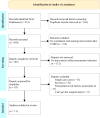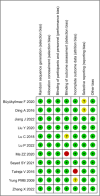Clinical Application Effect of Postoperative Nursing Intervention on Patients Undergoing Transurethral Prostatectomy: A Systematic Review and Meta-Analysis
- PMID: 40225246
- PMCID: PMC11992899
Clinical Application Effect of Postoperative Nursing Intervention on Patients Undergoing Transurethral Prostatectomy: A Systematic Review and Meta-Analysis
Abstract
Background: To study the clinical effect of postoperative nursing on patients undergoing transurethral resection of the prostate (TURP).
Methods: The relevant researches about nursing intervention effect evaluation after TURP during January 2000 to May 2024 were selected from databases. These were sorted into an intervention group (Int group) and a control group (Ctrl group) with different nursing methods. Theemotional status, length of hospital stays (LOHS), nursing satisfaction, the incidence, volume, and frequency of urinary incontinence (UI), and the incidences of urinary hemorrhage (UH), bladder spasm (BS), and catheter occlusion (CO) were compared after intervention.
Results: Eleven articles and 1,020 cases were included. The LOHS in the Int group was much shorter (mean difference (MD)=-2.91, 95% confidence interval (CI): -4.47~-1.35, Z=3.66, P=0.0002). The nursing satisfaction was significantly improved (odds ratio (OR)=5.70, 95% CI: 3.65-8.90, Z=7.64, P<0.00001). For complications, incidence of UI (OR=0.41, 95% CI: 0.26-0.66, Z=3.72, P=0.0002), the volume of UI (MD=-66.17, 95% CI: -124.74~-11.60, Z=2.36, P=0.02), and the frequency of UI (MD=-1.18, 95% CI: -1.69~-0.67, Z=4.55, P<0.00001) greatly reduced. The incidences of UH (OR=0.43, 95% CI: 0.21-0.87, Z=2.35, P=0.02), BS (OR=0.24, 95% CI: 0.14-0.42, Z=4.97, P<0.00001), and CO (OR=0.20, 95% CI: 0.11-0.36, Z=5.21, P<0.00001) were also highly reduced.
Conclusion: Postoperative nursing intervention could effectively shorten LOHS after TURP in patients with benign prostatic hyperplasia (BPH), improving the nursing satisfaction and reducing the incidence of postoperative complications.
Keywords: Meta-analysis; Nursing intervention; Postoperative; Transurethral resection of the prostate.
Copyright© 2025 Guo. Published by Tehran University of Medical Sciences.
Figures
Similar articles
-
Energy delivery systems for treatment of benign prostatic hyperplasia: an evidence-based analysis.Ont Health Technol Assess Ser. 2006;6(17):1-121. Epub 2006 Aug 1. Ont Health Technol Assess Ser. 2006. PMID: 23074487 Free PMC article.
-
Efficacy and Safety Evaluation of Transurethral Resection of the Prostate versus Plasmakinetic Enucleation of the Prostate in the Treatment of Massive Benign Prostatic Hyperplasia.Urol Int. 2021;105(9-10):735-742. doi: 10.1159/000511116. Epub 2021 Feb 1. Urol Int. 2021. PMID: 33524981
-
Bladder neck stenosis after transurethral prostate surgery: a systematic review and meta-analysis.World J Urol. 2021 Nov;39(11):4073-4083. doi: 10.1007/s00345-021-03718-1. Epub 2021 May 11. World J Urol. 2021. PMID: 33974100
-
[Effect of equal temperature bladder irrigation in patients with transurethral resection of prostate: A meta-analysis].Beijing Da Xue Xue Bao Yi Xue Ban. 2023 Aug 18;55(4):676-683. doi: 10.19723/j.issn.1671-167X.2023.04.018. Beijing Da Xue Xue Bao Yi Xue Ban. 2023. PMID: 37534651 Free PMC article. Chinese.
-
Transurethral microwave thermotherapy for the treatment of lower urinary tract symptoms in men with benign prostatic hyperplasia.Cochrane Database Syst Rev. 2021 Jun 28;6(6):CD004135. doi: 10.1002/14651858.CD004135.pub4. Cochrane Database Syst Rev. 2021. PMID: 34180047 Free PMC article.
References
Publication types
LinkOut - more resources
Full Text Sources



